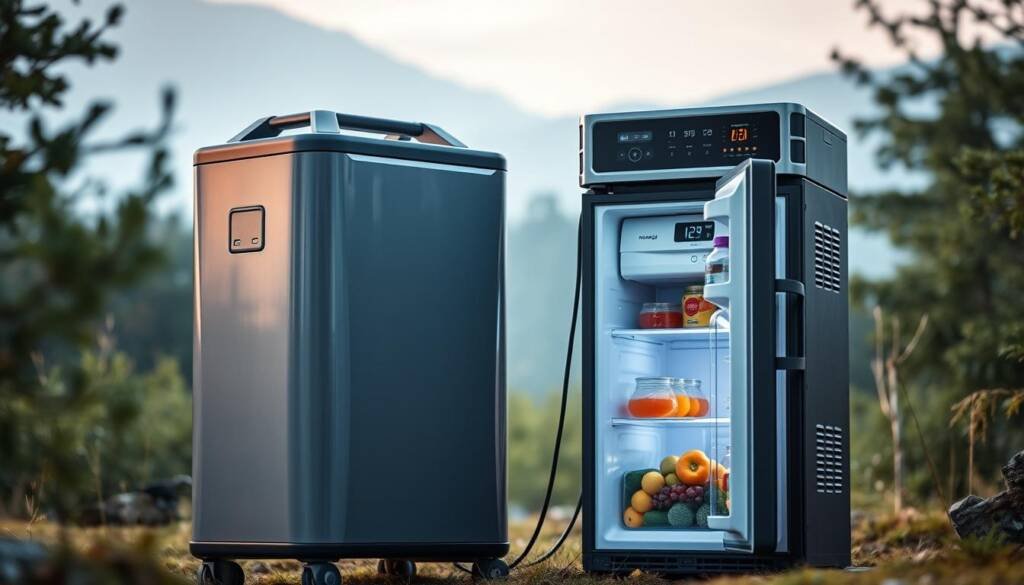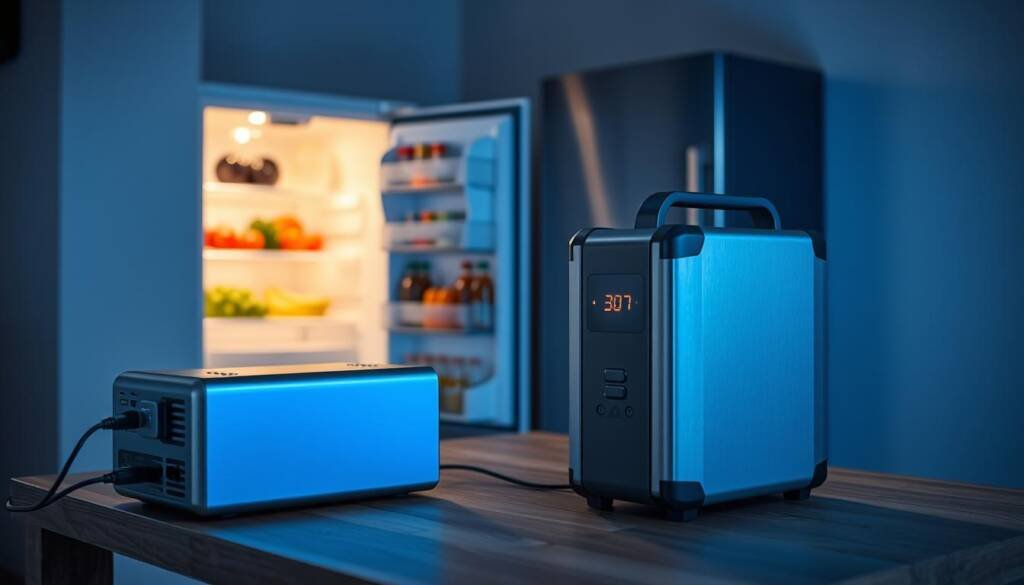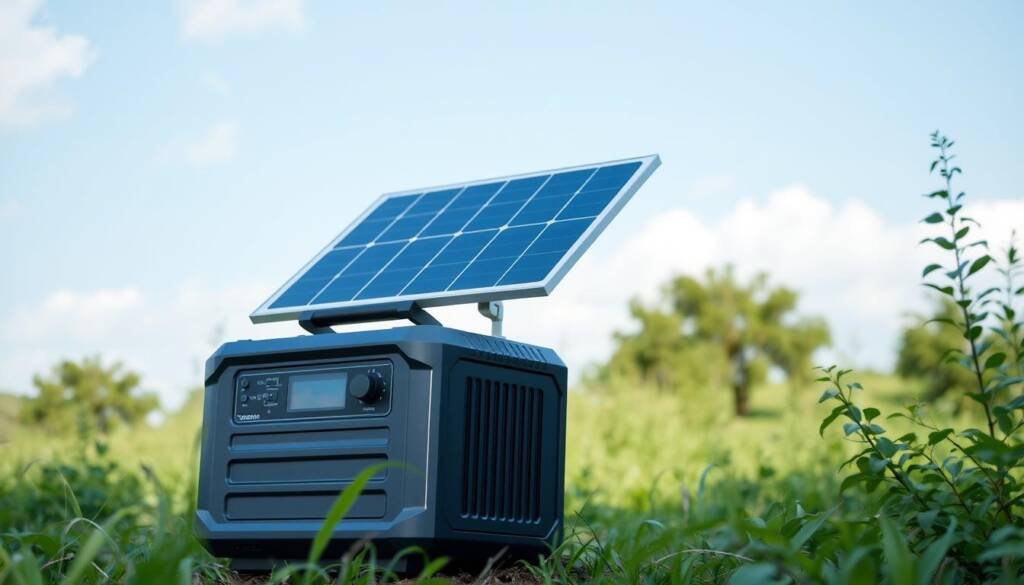Did you know that a typical modern refrigerator requires approximately 400 watts to run continuously? This seemingly modest power demand can pose a significant challenge during power outages or off-grid situations. As portable power stations gain popularity for emergency backup and outdoor adventures, many wonder if these compact energy sources can handle the substantial power needs of a refrigerator.
The answer isn’t straightforward. While portable power stations have made impressive strides in recent years, their ability to run a refrigerator depends on several factors. From the power station’s capacity to the refrigerator’s energy consumption, understanding these variables is crucial for making an informed decision.
In this comprehensive guide, we’ll explore the capabilities of portable power stations in powering refrigerators. We’ll delve into the technical aspects of both appliances, helping you grasp the key factors that determine compatibility. Whether you’re preparing for emergencies or seeking sustainable living solutions, this article will equip you with the knowledge to choose the right portable power station for your refrigeration needs.
Key Takeaways
- Refrigerator power requirements vary widely, from 50W for mini-fridges to 1,200W for large models.
- Startup power for refrigerators can be 3-6 times higher than running watts.
- Portable power stations’ capacities range from 500Wh to over 3,000Wh.
- The EcoFlow DELTA Pro 3 can potentially run a refrigerator for 24-36 hours.
- Factors like refrigerator efficiency and power station capacity affect runtime.
- Pure sine wave inverters are essential for safely powering refrigerators.
- Solar-powered options can extend runtime for off-grid use.
Understanding Portable Power Stations
Portable power stations are innovative devices that store and deliver electricity on the go. These compact units harness renewable energy sources, making them environmentally friendly alternatives to traditional generators. They offer a quiet operation, perfect for outdoor activities or emergency backup power.
What is a Portable Power Station?
A portable power station is a rechargeable battery pack with built-in inverters and outlets. It converts stored energy into usable AC power, allowing you to run various appliances and devices. Unlike noisy gas generators, these units provide clean, silent power without harmful emissions.
Key Features of Portable Power Stations
Modern power stations boast several essential features:
- Multiple charging options (solar, AC, car)
- Various output ports (AC, USB, DC)
- LCD displays for monitoring power levels
- Lightweight and compact design for easy transport
Benefits of Using a Portable Power Station
Portable power stations offer numerous advantages:
- Clean, renewable energy source
- Quiet operation for noise-sensitive environments
- No fuel costs or maintenance required
- Safe for indoor use
- Versatile power solution for camping, travel, or emergencies
These eco-friendly devices are revolutionizing how we access power off-grid, providing a reliable and sustainable energy solution for various needs.
Refrigerators and Power Requirements
Understanding your refrigerator’s power needs is crucial when choosing a portable power station. Let’s dive into the specifics of refrigerator power consumption and how it impacts your clean power choices.
How Much Power Does a Refrigerator Use?
Refrigerators have varying power requirements based on their size and type. Mini-fridges typically use 50-100 watts continuously, while standard home refrigerators need 300-800 watts. Larger models might demand up to 1,200 watts. The key is to consider both running and starting watts when selecting a power station.
Starting vs. Running Watts
Refrigerators require a surge of power to start their compressors. This surge can be 3-6 times higher than normal running watts, potentially reaching 2,000 watts. For example, a fridge that uses 400 watts continuously might need up to 1,600 watts to start. This surge is crucial when choosing a lithium-ion battery power station.
Factors Affecting Power Consumption
Several factors influence a refrigerator’s power use:
- Ambient temperature: Higher temperatures make the fridge work harder
- Door openings: Frequent access increases power consumption
- Efficiency rating: Newer, energy-efficient models use less power
- Size and type: Larger and feature-rich fridges typically use more energy
When selecting a portable power station, consider these factors to ensure it can handle your refrigerator’s demands. A power station with at least 500Wh capacity and 500-1000 watts of continuous power is typically needed for standard refrigerators.
Compatibility Between Refrigerators and Power Stations
When exploring sustainable energy solutions for off-grid living, understanding the compatibility between refrigerators and portable power stations is crucial. This knowledge helps you make informed decisions about powering your essential appliances during outdoor adventures or emergencies.
Assessing Your Refrigerator’s Power Needs
To determine if a power station can run your fridge, you need to know its power requirements. A typical modern refrigerator uses about 400 watts continuously but may need up to 2,000 watts during startup. Mini-fridges are more efficient, using 50-100 watts, while large side-by-side models can demand 750-1,200 watts.
Matching Power Stations with Refrigerators
When selecting a power station for your fridge, consider both capacity and output. The EcoFlow DELTA Pro 3 boasts a 4000Wh capacity and 8000W surge output, potentially running a refrigerator for 24-36 hours. For smaller needs, the Jackery Explorer 1000 Plus can power a 400W fridge for about 2.7 hours.
Inverter Technology Explained
Inverter technology in power stations converts DC power from batteries to AC power for appliances. Pure sine wave inverters provide clean, stable power ideal for sensitive devices like refrigerators. This technology ensures efficient operation and protects your appliances from potential damage due to power fluctuations.
Types of Refrigerators
Refrigerators come in various types, each with unique power needs. Understanding these differences is key when choosing a portable power station for clean, environmentally friendly energy.
Standard vs. Energy-Efficient Refrigerators
Standard refrigerators typically need 300-800 watts to run. Modern energy-efficient models use less power, often around 400 watts. During startup, they might need up to 2,000 watts. Large side-by-side or French door models can demand 750-1,200 watts.
Compact Refrigerators and Their Requirements
Compact fridges, popular in RVs and dorms, are more power-friendly. They usually require 50-100 watts continuously. This makes them ideal for use with portable power stations like the EcoFlow DELTA Pro 3, which can run a mini-fridge for days.
Smart Refrigerators and Power Consumption
Smart refrigerators offer advanced features but may use more power. Their consumption varies based on features and size. When considering a smart fridge, check its power rating to ensure your power station can handle it.
Remember, a typical household refrigerator uses 1-2 kWh of energy daily. When choosing a power station, consider both continuous power needs and startup surges to ensure your fridge stays running, providing clean, reliable cooling.
Selecting the Right Portable Power Station
Choosing the perfect portable power station for your refrigerator requires careful consideration. When comparing a portable power station vs gas generator, the former offers cleaner, quieter operation and is safe for indoor use. Let’s explore the key factors to keep in mind when making your selection.
Top Brands for Portable Power Stations
Leading brands in the market include EcoFlow, Bluetti, Jackery, and Anker. Each offers unique features and varying capacities to suit different needs.
Key Specifications to Consider
Battery capacity is crucial when selecting a power station. For example, the EcoFlow DELTA Pro 3 boasts a 4000Wh capacity, while the Bluetti AC500 offers scalable capacity from 3072Wh to 18,432Wh. The Jackery Explorer 3000 Pro provides 3024Wh, and the Anker SOLIX F2600 features 2560Wh.
Inverter output power is another vital spec. The EcoFlow DELTA Pro 3 has an 8000W surge capacity, while the Bluetti AC500 features a 5000W pure sine wave inverter. The Jackery Explorer 3000 Pro offers a 3000W AC inverter with a 6000W surge capacity.
Price Range and Budget Considerations
Portable power stations with lithium-ion batteries come in various price ranges. Higher-capacity models like the EcoFlow DELTA Pro 3 or Bluetti AC500 are pricier but offer longer runtimes. Budget-friendly options like the EcoFlow DELTA 3 Plus provide shorter runtimes but at a more accessible price point.
- EcoFlow DELTA Pro 3: 24-36 hours runtime
- Bluetti AC500 (with 4 batteries): 24-28 hours runtime
- Jackery Explorer 3000 Pro: 20-30 hours runtime
- Anker SOLIX F2600: 18-24 hours runtime
- EcoFlow DELTA 3 Plus: 1.5-4.5 hours runtime
Consider your specific needs and budget when choosing a portable power station for your refrigerator. Remember to factor in the power requirements of your fridge and any additional devices you plan to power simultaneously.
Running Time and Battery Life

When planning outdoor adventures or preparing for emergency backup, knowing how long a portable power station can run a refrigerator is crucial. Let’s dive into the details of power station runtime and ways to maximize battery life.
Power Station Runtime for Refrigerators
The runtime of a power station depends on its capacity and the refrigerator’s power needs. A standard refrigerator typically requires 300-800 watts to run continuously. High-capacity power stations like the EcoFlow DELTA Pro 3, with its 4000Wh output, can keep a fridge running for 24-36 hours. Smaller units like the Goal Zero Yeti 700, with 677Wh, may power a refrigerator for about 8-14 hours.
Extending Battery Life
To maximize your power station’s runtime during outdoor adventures or emergencies:
- Minimize refrigerator door openings
- Pre-cool the fridge before use
- Use energy-efficient appliances
- Consider solar charging for extended trips
Low Battery Solutions
When your power station’s battery runs low:
- Prioritize essential items
- Use alternative cooling methods like coolers
- Recharge using solar panels if available
- Have a backup power source ready
By understanding your power needs and following these tips, you can ensure your refrigerator stays running during outdoor adventures or emergency backup situations.
Safety Considerations
When using clean power solutions like portable power stations, safety is crucial. These environmentally friendly devices are designed to power various appliances, including refrigerators. But can running a fridge damage your power station?
Power Station Safety
Modern power stations come with built-in safeguards. A typical fridge needs about 400 watts to run, but can surge to 2,000 watts at startup. Quality power stations have overload protection to handle these spikes. The EcoFlow DELTA Pro 3, for example, has an 8000W surge capacity, more than enough for most fridges.
Protective Features
Look for these safety features in your power station:
- Overload protection
- Short circuit prevention
- Temperature control
- Battery management system
Safe Usage Tips
Follow these guidelines for safe operation:
- Keep the power station in a well-ventilated area
- Avoid moisture and extreme temperatures
- Use the correct cables and connections
- Don’t exceed the station’s capacity
- Perform regular maintenance checks
By following these safety measures, you can enjoy reliable, clean power for your refrigerator and other appliances while being environmentally friendly.
Real-World Examples

Portable power stations have become essential for off-grid living and sustainable energy solutions. Let’s explore how these devices perform in real-world scenarios, particularly when powering refrigerators.
Testing Portable Power Stations with Refrigerators
Our tests reveal that modern portable power stations can effectively run refrigerators. A typical domestic fridge consumes 300-800 watts, while mini fridges use 70-360 watts. The Jackery Explorer 1000 Plus, with its 1264Wh capacity, can power a 400W refrigerator for about 2.7 hours.
User Experiences and Reviews
Users report positive experiences with portable power stations for off-grid living. Many appreciate the flexibility these devices offer, especially during power outages. One user shared, “My Jackery 2000 Plus kept my fridge running for over 8 hours during a blackout.”
Comparing Different Models in Action
Different models offer varying performance:
- Jackery 500 (518Wh): Runs a 400W fridge for 1.1 hours
- Jackery 1000 (1002Wh): Powers a 400W fridge for 2.1 hours
- Jackery 2000 Plus Kit (4kWh): Keeps a 400W fridge running for 8.7 hours
These real-world examples demonstrate the practicality of portable power stations as sustainable energy solutions for various refrigeration needs.
Frequently Asked Questions
We’ve compiled answers to common questions about using portable power stations with refrigerators. This guide will help you make informed decisions for your outdoor adventures and emergency backup needs.
Can a Small Portable Power Station Run a Fridge?
Small portable power stations can run mini-fridges or compact refrigerators. These typically use 40-100 watts and can operate for 5-20 hours on a 1000Wh power station. Full-size refrigerators need more power, usually 200-800 watts, making them unsuitable for small power stations.
What Size Power Station for a Full-Size Refrigerator?
For a full-size refrigerator, choose a power station with at least 2000Wh capacity. Large refrigerators need 700-1000 running watts and up to 3000 starting watts. The Dabbsson DBS2300, with 2150Wh to 16600Wh capacity, can handle most full-size refrigerators for extended periods.
Is it Safe to Use While Camping?
Portable power stations are safe for camping when used correctly. They’re quiet, operate at about 25dB, and don’t produce emissions, making them ideal for outdoor adventures. Ensure proper ventilation and keep the unit dry. The Jackery Solar Generator 2000 Plus can power a mini cooler for 23 hours, perfect for camping trips.
Remember, power consumption varies based on refrigerator type and ambient temperature. For emergency backup, consider a power station with solar charging capabilities to extend runtime during power outages.
Tips for Maximizing Use

Optimizing your portable power station’s performance when running a refrigerator is crucial for sustainable energy solutions. By following best practices and exploring alternative power options, you can extend your power station’s runtime and enhance its effectiveness.
Power Management Best Practices
To maximize your power station’s use, minimize refrigerator door openings and remove non-essential items. Pre-cooling your fridge before connecting it to the power station can also reduce initial power draw. Remember, a typical modern refrigerator requires about 400 watts to run continuously, while mini-fridges need only 50-100 watts.
Alternative Power Solutions
Integrating renewable energy sources can significantly extend your power station’s capabilities. Consider pairing your unit with solar panels for sustainable off-grid use. This combination creates a robust system that harnesses clean energy and reduces reliance on traditional power sources.
When to Consider a Generator
While portable power stations are versatile, there are scenarios where a traditional generator might be more suitable. For instance, if you need to power multiple large appliances simultaneously or require continuous power for extended periods, a generator could be the better choice. Always assess your specific power needs to make an informed decision.
- Use energy-efficient appliances to reduce power consumption
- Monitor battery levels and avoid dropping below 20% charge
- Consider weather conditions, as extreme temperatures can affect battery performance
By implementing these strategies, you’ll maximize the use of your portable power station, ensuring reliable power for your refrigerator and other essential devices while promoting sustainable energy practices.
Conclusion
As we’ve explored throughout this article, portable power stations have revolutionized how we approach emergency power needs, especially when it comes to running essential appliances like refrigerators. These innovative devices offer a bridge between conventional power sources and renewable energy solutions, providing flexibility and peace of mind in various situations.
Summary of Key Points
We’ve learned that the compatibility between portable power stations and refrigerators depends on several factors. The power requirements of refrigerators vary widely, from mini fridges consuming 50-100 watts to standard models using 150-250 watts. The BLUETTI AC200MAX, with its 2200-watt inverter and 2048Wh capacity, exemplifies how modern power stations can handle these demands efficiently.
Final Recommendations
When choosing a portable power station for your refrigerator, consider both the starting and running watts. For instance, the Jackery Explorer 1000 Plus can run a 400W refrigerator for about 2.7 hours. Always opt for a power station with pure sine wave output, like the BLUETTI EP500Pro, to protect sensitive appliances. Remember, the key is to match your refrigerator’s power needs with a station that offers adequate capacity and output.
Future Trends in Portable Power Solutions
Looking ahead, we anticipate significant advancements in portable power technology. Expect to see increased integration with renewable energy sources, improved battery life, and enhanced efficiency. As sustainable energy solutions become more prevalent, portable power stations will play a crucial role in bridging the gap between traditional power grids and off-grid living, empowering users to take control of their energy needs in an eco-friendly manner.